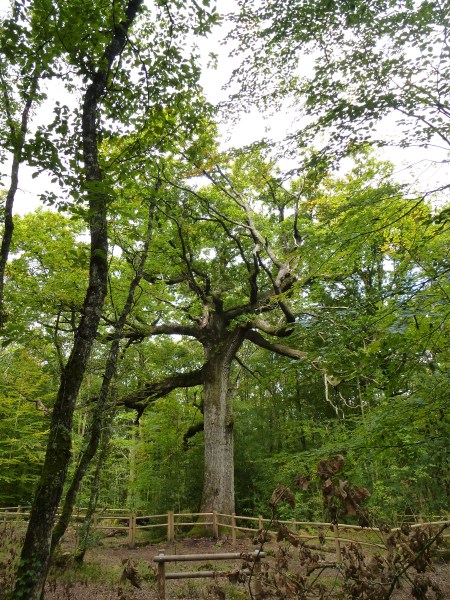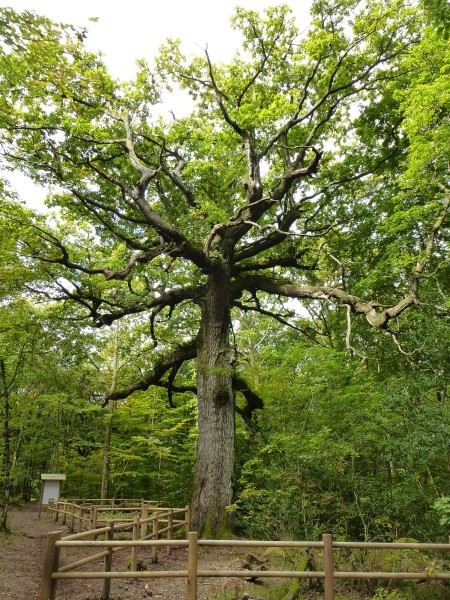I set off from Marlborough later than I had intended, delayed by a huge, deliciously lardy fried breakfast. By the time I had left the town and set off along the White Horse Trail the sun was already high and bright in a blue sky flecked with fluffy white clouds. Following the trail wasn’t always easy, with marker posts few and far between, but with the help of my trusty map I managed to stay mostly on the right path.

Setting off along the White Horse Trail, Wiltshire
The trail led me up out of the Kennet Valley, along the edges of dusty, stubbled fields, where a flock of nervous pheasants toddled anxiously in front of me before awkwardly taking flight in a flurry of angry croaks. I scrambled through overgrown hedgerows where my legs were stung by nettles and my clothes grabbed by brambles, then down again into the West Woods.

Looking across the valley towards the West Woods, Wiltshire
Here I came across the ancient Wansdyke, a long, meandering earthwork consisting of a high bank and deep ditch which stretches for miles across the Wiltshire countryside. The date or purpose of the dyke are not certain, although it seems to have been constructed sometime around the Saxon period, and may well have been defensive, its name apparently a derivation of ‘Woden’s Dyke’.

The bank and ditch of the Wansdyke, Wiltshire
Despite a couple of wrong turns along the network of trails in the shady forest, I eventually found the path again and soon ended up on a high ridge, looking south across the Vale of Pewsey. The views here were stunning, the low green hills fading to grey as they rolled gently into the distance.
It was obvious by now that I was nearing the magical landscape of Avebury. My map was dotted with little stars marked as Tumuli in that distinctive gothic script used by the Ordnance Survey to denote ‘sites of antiquity’. As I arrived at Knapp Hill I spotted the charmingly named Adam’s Grave, a long, low ancient burial place on the crest of a nearby hill.

Adam’s Grave, Wiltshire
The next stretch of my journey was uphill again, along the ancient Ridgeway which leads northwards from this spot toward the famous White Horse of Uffington. I was now walking in the footsteps of our ancestors going back centuries, maybe even millenia, as I puffed my way to the top of the ridge.

Walking the ancient Ridgeway, Wiltshire
Towards the summit I walked back across the Wansdyke, larger here but more overgrown with trees and scrub. The vista from the other side was magnificent, facing north now towards my destination. As I scuttled down the chalky, flint-flecked path two birds of prey, buzzards perhaps, or maybe red kites, wheeled and swooped playfully above me, their sharp cries cutting through the soft sigh of the breeze. The sun was hidden now, and I could see an ominous bank of grey cloud moving in speedily from the north.
I knew I was nearing my destination when I spotted the distinctive shape of Silbury Hill in the valley below. Soon I was in the pretty village of East Kennet, with its quiet lanes and thatched cottages, the wooded mound of East Kennet Long Barrow looming on the rise to my left. Not much later I took a short detour to see the impressive remains of West Kennet Long Barrow, now extensively excavated and open to curious visitors. Inside I noticed the strong scent of incense, and in one of the burial chambers I found a lit candle sitting next to a strange corn dolly, a pagan offering of some sort I suppose.

Huge stones around the entrance to West Kennet Long Barrow, Wiltshire
Sitting on top of the barrow offered more wonderful views of the surrounding fields, and also the opportunity to take of my heavy boots and grab something to eat. But before long I was up again, and walking down towards the main road, past an old oak tree hung with colourful ribbons and offerings, and on towards the village and prehistoric henge of Avebury.




























